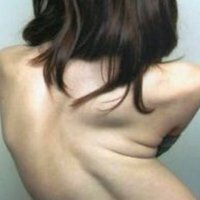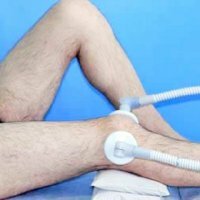Coxarthrosis: Symptoms and Treatment
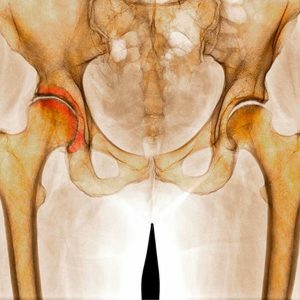
The term "coxarthrosis" refers to a severe lesion of the hip joint tissue - deforming osteoarthritis.This pathology, characterized by a progressive course, is more common in elderly patients;In people younger than 40 years, it develops in fairly rare cases.The incidence rate among males is higher than among women of the same age group.
The defeat can be either one-sided or two-way.In the second case, the joint of one leg suffers at first, and only after a while pathological changes affect another limb.
Contents: Causes Symptoms koksartroza joint degrees koksartroza hip Diagnosis and treatment of coxarthrosisCauses
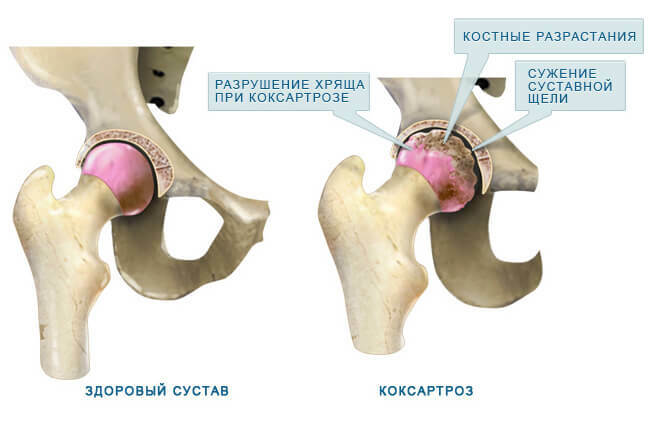
Pathogenetically decided to allocate two kinds of coxarthrosis:
- primary( idiopathic);
- secondary.
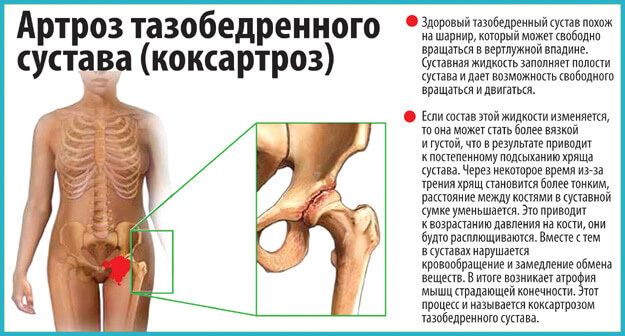
The exact causes of the development of the idiopathic form are currently unclear.
Factors leading to the development of a secondary species include:
- previously transmitted diseases;
- traumatic injuries;
- regular heavy physical exertion;
- is overweight;
- bone dysplasia;
- arthritis;
- infarction( aseptic necrosis) of the joint;
- congenital developmental disorders of the elements that make up the joint.
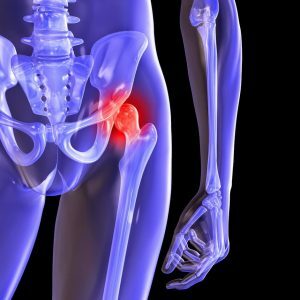 Note: repeatedly suffered microtraumas( injuries of the joint capsule and bone beams) in professional athletes, fans of "extreme" and people of dangerous occupations, often cause coxarthrosis.Even the most seemingly insignificant damages can make themselves felt after years and even decades.
Note: repeatedly suffered microtraumas( injuries of the joint capsule and bone beams) in professional athletes, fans of "extreme" and people of dangerous occupations, often cause coxarthrosis.Even the most seemingly insignificant damages can make themselves felt after years and even decades.
Currently, as a predisposing factor, specialists consider prolonged stress.Against this background, the blood level of corticosteroids, which reduces the biosynthesis of natural "lubrication" of joints - hyaluronic acid, significantly increases in blood.With its lack of cartilage have the property of thinning and cracking, that is, there are changes in the degenerative nature.
In addition, the nervous overvoltage contributes to the deterioration of the state of small blood vessels, resulting in impaired microcirculation, and, respectively, trophism and oxygenation( saturation with oxygen) of the joint tissues.
Chronic endocrine diseases( diabetes mellitus), a significant change in the hormonal background during the menopause, as well as osteoporosis and sensitivity disorder in the lower extremities against a background of neurological pathologies can have definite significance.
Symptoms of joint coxarthrosis
Symptomatic of this articular pathology is gradually growing, in this connection, the patient has time to partly get used to it.In a number of cases, this is the reason for late seeking help from a specialist.
As a rule, the first clinical manifestation of the disease is an easy or moderate pain syndrome with normal physical activity( walking) during the day or by the evening .In some cases, the initial symptom is a pulling sensation in the groin area, which does not cause any particular inconvenience or anxiety.As the pathological process progresses, the intensity of pain when walking gradually increases, and a person can walk a shorter distance without making stops.
Important! If during the day there was a significant load on the lower limbs, then at night there are quite intense pains of a pulling character in the problem joint.
It is the growing pain syndrome in the vast majority of cases that is the reason for contacting a doctor.However, many patients for a long time engaged in self-medication, using the dubious advice of friends, and taking analgesics to mute the leading symptom.
With the passage of time, the pain syndrome during walking assumes a constant character, and more and more often makes itself felt at rest. Conventional analgesic drugs practically do not help it to stop.The pain forces the patient to adjust, reducing the load on the leg - this is how the lameness develops.Reducing the load, in turn, causes the hypotrophy of muscle tissue.At visual inspection it is often noticeable that the muscles of the diseased limb are smaller in volume in comparison with the healthy leg.
To prevent or reduce the severity of pain in the affected joint, patients subconsciously reduce the amplitude of movements, and this leads to persistent changes - contractures.Progression of deforming osteoarthritis causes shortening of the limb, as a result of which lameness becomes more pronounced.
Note: with coxarthrosis creates a kind of vicious circle - the appearance of some symptoms provokes the development of others, and they contribute to the progression of the former.A pronounced change in gait is the cause of biomechanical disturbance of all elements and structures of the musculoskeletal system.Since there is a significant redistribution of the load, over time there are severe pain in the lumbar region, the pelvis twists and the spine warps.Such a complex of disorders adversely affects the function of walking and contributes to the progression of the leading symptoms.
With time, the knee of the affected limb begins to ache. Progressive coxarthrosis leads to severe dysfunction of the affected joint, which most negatively affects the quality of life of the patient .Over time, he is deprived of the possibility of normal movement without outside help.
Degrees of coxarthrosis of the hip
Depending on the degree of joint dysfunction, the volume of movements in it and the severity of the pain syndrome, it is customary to distinguish 3 clinical stages( degrees) of the disease.Often, they do not correlate with the changes determined during the X-ray study, so the staging does not always become a determining factor in the preparation of a treatment plan.

For the 1st( easiest) degree, pains are characteristic in the hip( less often - and knee) joint, which grow at the load and pass independently at rest.The amplitude of the movements is normal, and lameness is absent.
The 2nd degree is characterized by an increase in the intensity of the pain syndrome, its irradiation to the knee area and groin.Rest does not stop the pain, and after a fairly long load there is a change in gait( lameness).The amplitude of movements in the hip joint is reduced.Muscular weakness of the leg muscles develops, which causes muscle weakness.
Note: for coxarthrosis is quite typical for spreading from the inguinal area down to the middle of the thigh or to the knee along the anterior or lateral surface of the
. As the disease develops, a symptom often arises, like a distinct crunch in the affected joint during movement.It is caused by the friction of surfaces that, due to dystrophic changes, cease to correspond perfectly to each other.
With the 3rd degree, the pain becomes permanent.They disturb at night, as a result of which sleep is disturbed and the exhaustion of the nervous system develops.A sharp restriction of mobility leads to a sharp hypotrophy of all limb muscles from the buttocks to the shin.Patients have to move around using a cane.The pelvis twists, causing the leg to become shorter, and the lameness becomes more pronounced.
Diagnosis and treatment of coxarthrosis
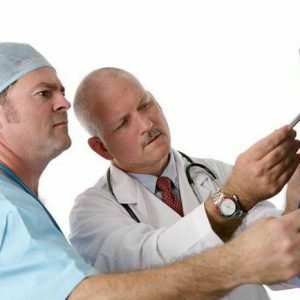 The basis for the diagnosis is the history data that is collected during the survey and the results of the X-ray study.At 2-3 stages in the picture pathological changes in the bone and joint space are clearly visible.
The basis for the diagnosis is the history data that is collected during the survey and the results of the X-ray study.At 2-3 stages in the picture pathological changes in the bone and joint space are clearly visible.
Treatment of this disease is a very difficult task for both the doctor and the patient.The main goal of therapeutic measures is to ensure the normal functioning of the affected joint without pain.
At the initial stages of pathology development, the most important task is to stop the progression of the process and to stop the pain syndrome.The patient needs to take analgesics, regularly perform a set of specially designed exercises, follow a prescribed diet and change the habitual way of life.A good therapeutic effect allows you to achieve acupuncture and physiotherapy.
At the first stage, deformation and destruction of tissues can be stopped.Chances of full preservation of functions are very great.
Drugs from the NSAID group - Ketorol, Ketonal or Diclofenac( in tablets or as a solution for intramuscular injection) are prescribed to relieve the pain syndrome.These drugs can reduce inflammation and associated puffiness.Do not take them for a long time, because one of their side effects is a decrease in the ability of cartilage tissue to regenerate.In particular, Diclofenac is expedient to accept short courses( no more than 5 days).In the event that prolonged therapy aimed at the removal of inflammation is shown, it is recommended to give preference to the drug Movalis.
To accelerate the regeneration of the affected cartilage of the joint, the microcirculation in the affected area needs to be improved.To this end, prescribed drugs that have vasodilating properties - for example, Cinnarizine or Trental.
To buy muscle spasm, and as a result to reduce pain and improve blood flow, help is provided to the funds belonging to the clinical and pharmacological group of muscle relaxants.

Chondroprotectors slow down the degeneration of the cartilage and promote its recovery.With their help in some cases it is possible to stop the progression of the disease.The most effective drugs in this category are Teraflex and Arthroglycan.
Important: after discontinuation of chondroprotective therapy, the cartilage regeneration process continues for some time.
High intensity of pain syndrome, as well as concomitant inflammation of muscle tissue and tendons become the basis for prescribing hormonal medicines to the patient - Kenalog or Hydrocortisone in the form of solutions for intraarticular injections.The effect after the introduction of these drugs in the joint cavity is maintained for a long time.
The effectiveness of topical topical preparations( gels and ointments) is rather doubtful, since a very small amount of active substance penetrates directly to the joint through the skin and underlying soft tissues.Not bad help rubbing warming ointments, because these procedures contribute to improving local blood flow and stopping muscle spasms.
Please note: manual therapy can certainly help with coxarthrosis, but in this case, the qualification of a specialist is of great importance.Wrong actions of a manual can quite become the reason of deterioration of a condition.
The main task of physiotherapy is stimulation of local blood circulation and elimination of spasm of musculature.
The most effective physiotherapeutic methods for the treatment of coxarthrosis:
- inductothermy;
- cryotherapy;
- electrotherapy;
- laser therapy;
- magnetotherapy;
- phototherapy;
- therapeutic massage.
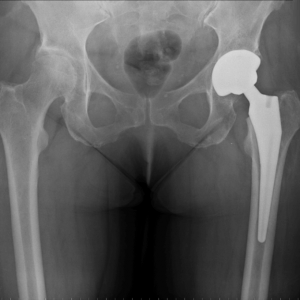 The complex of therapeutic exercises for each patient is selected strictly individually, taking into account the stage of the disease and the dynamics of the process.Gymnastics allows you to strengthen the muscles and significantly improve blood circulation in the affected limb.
The complex of therapeutic exercises for each patient is selected strictly individually, taking into account the stage of the disease and the dynamics of the process.Gymnastics allows you to strengthen the muscles and significantly improve blood circulation in the affected limb.
It is noted that a good therapeutic effect can be achieved by swimming in sea water.
In the third stage of coxarthrosis, conservative measures are ineffective.Positive results can be achieved only in 10% of cases.At this stage of pathology development, surgical treatment is shown, which consists in endoprosthetics - replacement of the affected joint with an artificial construction.
Important: surgical intervention at the 3rd stage of deforming osteoarthritis of the hip joint in the state clinics of the Russian Federation is free of charge with quotas for a program of high-tech medical care for the population.
Chumachenko Olga, medical reviewer


